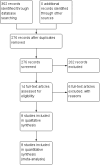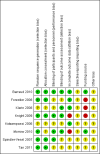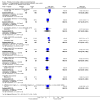Probiotics for preventing ventilator-associated pneumonia
- PMID: 25344083
- PMCID: PMC4283465
- DOI: 10.1002/14651858.CD009066.pub2
Probiotics for preventing ventilator-associated pneumonia
Abstract
Background: Ventilator-associated pneumonia (VAP) is common in intensive care units (ICUs). Some evidence indicates that probiotics may reduce the incidence of VAP. Several additional published studies have demonstrated that probiotics are safe and efficacious in preventing VAP in ICUs. We aimed to systematically summarise the results of all available data to generate the best evidence for the prevention of VAP.
Objectives: To evaluate the effectiveness and safety of probiotics for preventing VAP.
Search methods: We searched CENTRAL (2014, Issue 8), MEDLINE (1948 to September week 1, 2014) and EMBASE (2010 to September 2014).
Selection criteria: Randomised controlled trials (RCTs) comparing probiotics with placebo or another control (excluding RCTs that use probiotics in both study groups) to prevent VAP.
Data collection and analysis: Two review authors independently assessed eligibility and the quality of trials, and extracted data.
Main results: We included eight RCTs, with 1083 participants. All studies compared a form of probiotic (Lactobacillus casei rhamnosus; Lactobacillus plantarum; Synbiotic 2000FORTE; Ergyphilus; combination Bifidobacterium longum + Lactobacillus bulgaricus + Streptococcus thermophilus) versus a control group (placebo; glutamine; fermentable fibre; peptide; chlorhexidine). The analysis of all RCTs showed that the use of probiotics decreased the incidence of VAP (odds ratio (OR) 0.70, 95% confidence interval (CI) 0.52 to 0.95, low quality evidence). However, the aggregated results were uncertain for ICU mortality (OR 0.84, 95% CI 0.58 to 1.22 very low quality evidence), in-hospital mortality (OR 0.78, 95% CI 0.54 to 1.14, very low quality evidence), incidence of diarrhoea (OR 0.72, 95% CI 0.47 to 1.09, very low quality evidence), length of ICU stay (mean difference (MD) -1.60, 95% CI -6.53 to 3.33, very low quality evidence), duration of mechanical ventilation (MD -6.15, 95% CI -18.77 to 6.47, very low quality evidence) and antibiotic use (OR 1.23, 95% CI 0.51 to 2.96, low quality evidence). Antibiotics for VAP were used for a shorter duration (in days) when participants received probiotics in one small study (MD -3.00, 95% CI -6.04 to 0.04). However, the CI of the estimated effect was too wide to exclude no difference with probiotics. There were no reported events of nosocomial probiotic infections in any included study.The overall methodological quality of the included studies, based on our 'Risk of bias' assessments, was moderate with half of the included studies rated as a 'low' risk of bias; however, we rated four included studies as a 'high' risk of bias across one or more of the domains. The study limitations, differences in probiotics administered and participants, and small sample sizes across the included studies mean that the power to detect a trend of overall effect may be limited and chance findings cannot be excluded.To explore the influence of some potential confounding factors in the studies, we conducted an intention-to-treat (ITT) analysis, which did not change the inference of per-protocol analysis. However, our sensitivity analysis did not indicate a significant difference between groups for instances of VAP.
Authors' conclusions: Evidence suggests that use of probiotics is associated with a reduction in the incidence of VAP. However, the quality of the evidence is low and the exclusion of the one study that did not provide a robust definition of VAP increased the uncertainty in this finding. The available evidence is not clear regarding a decrease in ICU or hospital mortality with probiotic use. Three trials reported on the incidence of diarrhoea and the pooled results indicate no clear evidence of a difference. The results of this meta-analysis do not provide sufficient evidence to draw conclusions on the efficacy and safety of probiotics for the prevention of VAP in ICU patients.
Conflict of interest statement
Lulong Bo: none known. Jinbao Li: none known. Tianzhu Tao: none known. Yu Bai: none known. Xiaofei Ye: none known. Richard S Hotchkiss: none known. Marin H Kollef: Dr Kollef has done consulting work for Merck and Cubist and has provided lectures for Cubist and Hospira. Neil H Crooks: Dr Neil Crooks has been awarded internal and external funding for a pilot study on probiotics in the critical care population. The study is registered on the EudraCT database (No 2011‐002343‐99). Xiaoming Deng: none known.
Figures

























Comment in
-
What do Cochrane systematic reviews say about probiotics as preventive interventions?Sao Paulo Med J. 2017 Nov-Dec;135(6):578-586. doi: 10.1590/1516-3180.2017.0310241017. Sao Paulo Med J. 2017. PMID: 29267517 Free PMC article.
References
References to studies included in this review
Barraud 2010 {published data only}
-
- Barraud D, Blard C, Hein F, Marcon O, Cravoisy A, Nace L, et al. Probiotics in the critically ill patient: a double blind, randomized, placebo‐controlled trial. Intensive Care Medicine 2010;36(9):1540‐7. - PubMed
Forestier 2008 {published data only}
Klarin 2008 {published data only}
Knight 2009 {published data only}
-
- Knight D, Gardiner D, Banks A, Snape SE, Weston VC, Bengmark S, et al. Effect of synbiotic therapy on the incidence of ventilator associated pneumonia in critically ill patients: a randomised, double‐blind, placebo‐controlled trial. Intensive Care Medicine 2009;35(5):854‐61. - PubMed
-
- Knight D, Girling K, Banks A, Snape S, Weston V, Bengmark S. The effect of enteral synbiotics on the incidence of ventilator‐associated pneumonia in mechanically ventilated critically ill patients. Critical Care 2006;10(Suppl 1):P213 (abstract number).
Kotzampassi 2006 {published data only}
-
- Giamarellos‐Bourboulis EJ, Bengmark S, Kanellakopoulou K, Kotzampassi K. Pro‐ and synbiotics to control inflammation and infection in patients with multiple injuries. Journal of Trauma 2009;67:815–21. - PubMed
-
- Kotzampassi K, Giamarellos‐Bourboulis EJ, Voudouris A, Kazamias P, Eleftheriadis E. Benefits of a synbiotic formula (Synbiotic 2000Forte) in critically Ill trauma patients: early results of a randomized controlled trial. World Journal of Surgery 2006;30(10):1848‐55. - PubMed
Morrow 2010 {published data only}
-
- Morrow LE. Probiotics in the intensive care unit. Critical Care 2009;15(2):144‐8. - PubMed
-
- Morrow LE, Kollef MH, Bowers JB, Casale TB. Probiotic manipulation of the native flora in critically ill patients: an opportunity for ventilator‐associated pneumonia prophylaxis? [Abstract]. American Journal of Respiratory and Critical Care Medicine 2005;128(4):144s.
Spindler‐Vesel 2007 {published data only}
-
- Spindler‐Vesel A, Bengmark S, Vovk I, Cerovic O, Kompan L. Synbiotics, prebiotics, glutamine, or peptide in early enteral nutrition: a randomized study in trauma patients. Journal of Parenteral and Enteral Nutrition 2007;31(2):119‐26. - PubMed
References to studies excluded from this review
Besselink 2008 {published data only}
-
- Besselink GHM, Santvoort HC, Buskens E, Boermeester MA, Goor H, et al. Probiotic prophylaxis in predicted severe acute pancreatitis: a randomised, double‐blind, placebo‐controlled trial. Lancet 2008;371(9613):651‐9. - PubMed
Cimperman 2011 {published data only}
-
- Cimperman L, Bayless G, Best K, Diligente A, Mordarski B, Oster M, et al. A randomized, double‐blind, placebo‐controlled pilot study of Lactobacillus reuteri ATCC 55730 for the prevention of antibiotic‐associated diarrhoea in hospitalized adults. Journal of Clinical Gastroenterology 2011;45(9):785‐9. - PubMed
Eren 2010 {published data only}
Oudhuis 2011 {published data only}
Perez 2010 {published data only}
-
- Perez N, Iannicelli JC, Girard‐Bosch C, Gonzalez S, Varea A, Disalvo L, et al. Effect of probiotic supplementation on immunoglobulins, isoagglutinins and antibody response in children of low socio‐economic status. European Journal of Nutrition 2010;49(3):173‐9. - PubMed
References to ongoing studies
Thamlikitkul 2011 {unpublished data only}
-
- Probiotics for prevention of ventilator‐associated pneumonia (VAP). Ongoing study December 2011.
Additional references
ATS/IDSA 2005
-
- American Thoracic Society, Infectious Diseases Society of America. Guidelines for the management of adults with hospital‐acquired, ventilator‐associated, and healthcare‐associated pneumonia. American Journal of Respiratory and Critical Care Medicine 2005;171:388‐416. - PubMed
Bouza 2009
-
- Bouza E, Burillo A. Advances in the prevention and management of ventilator‐associated pneumonia. Current Opinion in Infectious Diseases 2009;22(4):345‐51. - PubMed
Gareau 2010
Gibson 1995
-
- Gibson GR, Roberfroid MB. Dietary modulation of the human colonic microbiota: introducing the concept of prebiotics. Journal of Nutrition 1995;125(6):1401‐12. - PubMed
Grap 2012
-
- Grap MJ, Munro CL, Unoki T, Hamilton VA, Ward KR. Ventilator‐associated pneumonia: the potential critical role of emergency medicine in prevention. Journal of Emergency Medicine 2012;42(3):353‐62. - PubMed
Gu 2012
-
- Gu WJ, Wei CY, Yin RX. Lack of efficacy of probiotics in preventing ventilator‐associated pneumonia: a systematic review and meta‐analysis of randomized controlled trials. Chest 2012;142(4):859‐68. - PubMed
Higgins 2011
-
- Higgins JPT, Green S (editors). Cochrane Handbook for Systematic Reviews of Interventions Version 5.1.0 [updated March 2011]. The Cochrane Collaboration, 2011. Available from www.cochrane‐handbook.org.
Isakow 2007
-
- Isakow W, Morrow LE, Kollef MH. Probiotics for preventing and treating nosocomial infections: review of current evidence and recommendations. Chest 2007;132(1):286‐94. - PubMed
Jain 2004
-
- Jain PK, McNaught CE, Anderson AD, MacFie J, Mitchell CJ. Influence of synbiotic containing Lactobacillus acidophilus La5, Bifidobacterium lactis Bb 12, Streptococcus thermophilus, Lactobacillus bulgaricus and oligofructose on gut barrier function and sepsis in critically ill patients: a randomised controlled trial. Clinical Nutrition 2004;23(4):467‐75. - PubMed
Klein 1998
-
- Klein G, Pack A, Bonaparte C, Reuter G. Taxonomy and physiology of probiotic lactic acid bacteria. International Journal of Food Microbiology 1998;41(2):103‐25. - PubMed
Kollef 2005
-
- Kollef MH, Shorr A, Tabak YP, Gupta V, Liu LZ, Johannes RS. Epidemiology and outcomes of health‐care‐associated pneumonia: results from a large US database of culture‐positive pneumonia. Chest 2005;128(6):3854‐62. - PubMed
Lefebvre 2011
-
- Lefebvre C, Manheimer E, Glanville J. Chapter 6: Searching for studies. In: Higgins JPT, Green S (editors). Cochrane Handbook for Systematic Reviews of Interventions Version 5.1.0 [updated March 2011]. The Cochrane Collaboration, 2011. Available from www.cochrane‐handbook.org.
Petrof 2012
-
- Petrof EO, Dhaliwal R, Manzanares W, Johnstone J, Cook D, Heyland DK. Probiotics in the critically ill: a systematic review of the randomized trial evidence. Critical Care Medicine 2012;40(12):3290‐302. - PubMed
Rello 2002
-
- Rello J, Ollendorf DA, Oster G, Vera‐Llonch M, Bellm L, Redman R, et al. Epidemiology and outcomes of ventilator‐associated pneumonia in a large US database. Chest 2002;122(6):2115‐21. - PubMed
Rello 2010
-
- Rello J, Chastre J, Cornaglia G, Masterton R. A European care bundle for management of ventilator‐associated pneumonia. Journal of Critical Care 2010;26(1):3‐10. - PubMed
RevMan 2014 [Computer program]
-
- The Nordic Cochrane Centre, The Cochrane Collaboration. Review Manager (RevMan). Version 5.3. Copenhagen: The Nordic Cochrane Centre, The Cochrane Collaboration, 2014.
Richards 1999
-
- Richards MJ, Edwards JR, Culver DH, Gaynes RP. Nosocomial infections in medical intensive care units in the United States. National Nosocomial Infections Surveillance System. Critical Care Medicine 1999;27(5):887‐92. - PubMed
Schrezenmeir 2001
-
- Schrezenmeir J, Vrese M. Probiotics, prebiotics, and synbiotics ‐ approaching a definition. American Journal of Clinical Nutrition 2001;73(Suppl 2):361‐4. - PubMed
Schünemann 2008
-
- Schünemann HJ, Oxman AD, Vist GE, Higgins JPT, Deeks JJ, Glasziou P, et al. Chapter 12: Interpreting results and drawing conclusions. In: Higgins JPT, Green S editor(s). Cochrane Handbook for Systematic Reviews of Interventions. Chichester, UK: Wiley‐Blackwell, 2008:359‐83.
Siempos 2010
-
- Siempos II, Ntaidou TK, Falagas ME. Impact of the administration of probiotics on the incidence of ventilator‐associated pneumonia: a meta‐analysis of randomized controlled trials. Critical Care Medicine 2010;38(3):954‐62. - PubMed
Valencia 2009
-
- Valencia M, Torres A. Ventilator‐associated pneumonia. Current Opinion in Critical Care 2009;15(1):30‐5. - PubMed
Van Silvestri 2010
-
- Silvestri L, Saene HK, Gregori D, Agostini S, Francescon M, Taylor N. Probiotics to prevent ventilator‐associated pneumonia: no robust evidence from randomized controlled trials. Critical Care Medicine 2010;38(7):1616‐7. - PubMed
Publication types
MeSH terms
Grants and funding
LinkOut - more resources
Full Text Sources
Other Literature Sources

